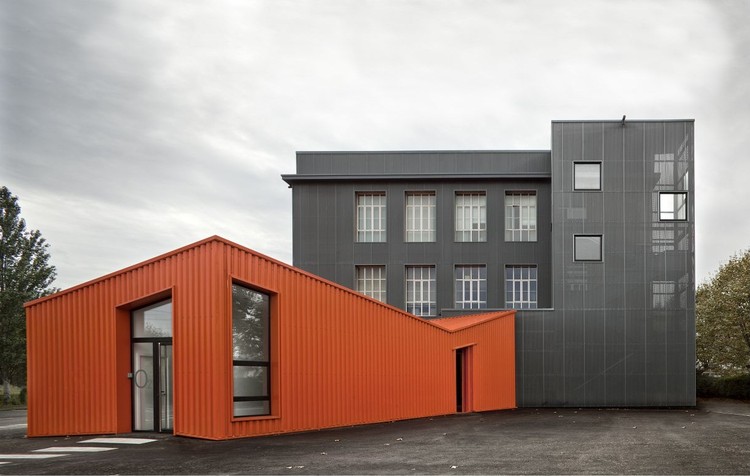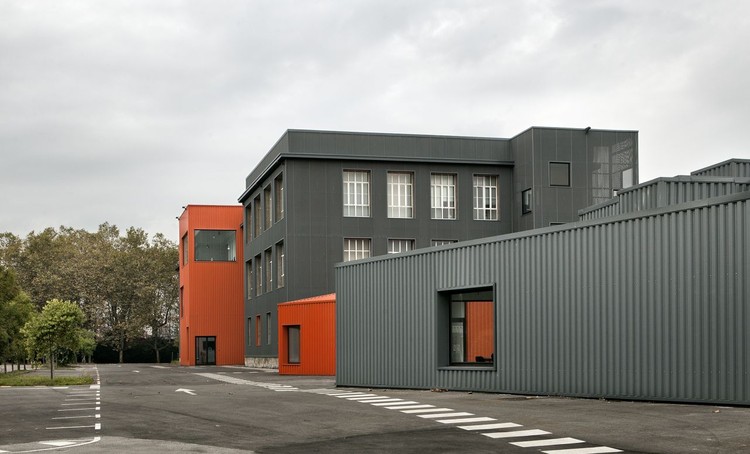
-
Architects: [baragaño]
- Year: 2012
-
Photographs:Mariela Apollonio

Text description provided by the architects. The origin of the project was the need expressed by ArcelorMittal’s Global R&D Centre at Aviles, located in this building, to have more workspace. An existing building, rational, symmetric, with a heavy architecture, heavy concrete walls and brick facades, that have been already extended in the 70´s.

The inside-out sushi roll, also known as Uramaki, has the peculiarity that the rice is on the outside and the nori (seaweed) is on the inside, surrounding the filling. This is why it is referred to as an inside-out roll. In this project, the vision was to play with these concepts with reference to the inside and outside of the building, the city and the materials. Endeavouring both to connect ArcelorMittal’s Global R&D Centre to the city of Aviles and, simultaneously, displaying the steel, a material that is produced in the plant (in the city) and that was not apparent in the refurbished centre.

Steel, a material that enters and exits the building, cladding facades, stairs, the roof, which can be understood to be continuous, in reference to the rolling-mills in which it is produced, as well as to the world’s leading steel producer and to a city, Aviles, always a focal point and with a priceless industrial heritage.

The building in which ArcelorMittal develops new and more efficient ways to produce this material must communicate solely through its external appearance the primary, metal-oriented purpose of its activity. It has become an exemplar of how steel construction is able to give spaces new life, gaining in terms of both comfort and quality. Several basic criteria were established for the refurbishment: prioritise the safety of the building’s users, keep costs low, offer a maximum of services and use ArcelorMittal’s own products. The solution has connected the R&D Centre with the city of Aviles and also showcases steel as a construction material for facades and roofs. All of this has provided the complex with a clear continuity.

The metal parts can be 100% reused and 70% of them came from recycled steel. The project has two fundamental lines of action: firstly, the restoration of spaces, facades and functionalities in the existing building and secondly, the construction of two new buildings.. _Cladding of the Aviles Technology Development Centre building with perforated steel plate.

The front facade, where brick and concrete predominated, has acquired a new metal fascia. ArcelorMittal’s corporate colours, dark grey and orange, now predominate. This will use 2,200 square metres of Arval Fréquence 14.18 micro-perforated lacquered sheet steel in Anthracite 6798, mounted on battens comprising 100x100x3 square-section tubes.

Internally, the lobby has already been renovated to vertically connect the building’s three floors through the new Atrio, the new entrance of the building, where a structure of rolled sections was employed, primarily HEA sections in sizes 120, 200, 220 and 360 in grade S275, Hacierba liner trays and Arval Chantilly sheet painted in Orange. _Construction of two low-rise buildings alongside the Technology Development Centre.

The first one, named Open Office contains two meeting rooms, toilets and a rest area. Its structure consists of rolled sections, primarily IPE220 and HEA 120 in grade S275. Chantilly sheet painted in orange was also used.

The second one is the Finger Lab, has an energy, environment and process simulation laboratory, as well as meeting rooms. Its structure consists of rolled sections, primarily IPE220 and HEA 120 in grade S275. Hacierba liner trays and Chantilly sheet painted in Anthracite were also used.

Finally, the car park was refurbished, increasing the number of spaces and the green areas were rehabilitated, creating a new way of parking, more dynamic and consistent with the operation of the centre.




























